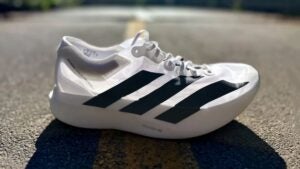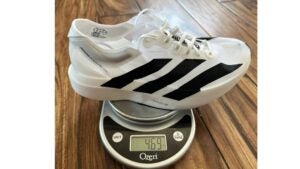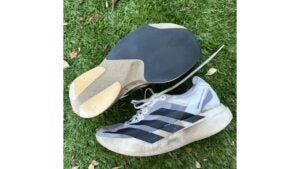New perk! Get after it with local recommendations just for you. Discover nearby events, routes out your door, and hidden gems when you sign up for the Local Running Drop.
This article was originally published on RUN.
Designing shoes to improve running speed isn’t a novel concept. Long before the advent of plated super shoes, ultralight, minimalist footwear helped runners achieve faster race times. These lightweight shoes represented a form of performance-enhancing super shoe, as research extensively shows that a shoe’s weight significantly influences running performance. The lighter the shoe, the faster you can run. One study revealed that for every 100-gram (3.5 oz) addition in shoe weight, a 1.11 percent decrease in running economy could be expected.
In 2017, the arrival of the Nike Vaporfly 4% disrupted the idea that weight alone dictates a shoe’s speed. Instead of focusing solely on featherlight designs, new, bouncy foams enabled the creation of thick-soled, heavily cushioned racing shoes featuring a rigid, curved, carbon-fiber plate embedded in the midsole—a design that nearly doubled the weight of the lightest minimal racers, yet delivered a far superior performance.
At the 2023 Berlin Marathon, however, Tigist Assefa smashed the women’s marathon world record wearing a new Adidas prototype called the Adizero Adios Pro Evo 1 that was as light as any “racing flat,” yet still highly cushioned and plated. They’ve since been worn by 11 marathon winners, including this spring’s Boston Marathon champion Sisay Lemma.
After Assefa’s record-breaking performance, a media frenzy surrounded the new shoe. The spotlight focused mostly on its hefty $500 price tag and the brand’s claim (printed on a card included in the box) that it was optimized to endure only one marathon and an unspecified “familiarization period.” Was it really that fragile, we wondered, or could it surpass expectations? Thus, we subjected it to one of the most rigorous running shoe tests we’ve ever conducted. What we found surprised us.

Adidas Adizero Adios Pro Evo 1 Specs
- Price: $500
- Weight: 4.9 oz. (unisex)
- Stack Heights: 39mm (heel), 33mm (forefoot)
- Offset: 6mm
How We Tested
I’ve been testing running shoes for Outside since 2015, and this is the most thorough test I’ve done on a pair of shoes. For the past six months I’ve pushed the Evo 1 to the brink of destruction. I’ve taken them on concrete, pavement, tracks, and grass. I’ve done 14-mile marathon-type workouts that included several miles at marathon pace, and short maximum-speed track workouts. I’ve run one 5K road race and one 3K track race in them. Adidas advertises the Evo 1 is optimized for elite and competitive runners up to a 3:30 marathon time (8 minutes per mile pace), so I ran almost all my miles at that pace or faster.
Adidas Adizero Adios Pro Evo 1 Review
Upon learning about the adidas Adizero Adios Pro Evo 1, I couldn’t wait to put them to the test. Shelling out $500 for a shoe optimized for a single marathon seems ridiculously extravagant. However, if it could withstand three to four marathons, that lofty price tag might become more justifiable. We wanted to find out how crazy the price was, so I set out to run in them until they were worn so much I’d no longer choose them for a race.
My first experience just holding the Evo 1 left me utterly amazed. The shoe felt so weightless in my hand it seemed almost to float. At 4.9 ounces, it’s nearly two ounces lighter than the next lightest super shoe (Nike ZoomX Vaporfly NEXT% 3 at 6.5 ounces).

I quickly moved my speed workout up one day to put these to the test as soon as possible. My planned workout was 4 miles alternating between 10-mile race pace and marathon race pace. Not knowing how long they would last, I stepped gingerly as I started my workout, as if the shoes were made of glass. Once I started running, the first steps were pure bliss, mixed with a bit of disbelief. How could a shoe be this lightweight yet have so much cushioning and a stack height of 39mm in the heel, 33mm under the forefoot?
To accomplish this record-breaking featherweight feat, Adidas forgoes the sock liner (aka insole), which typically weighs between half an ounce to three-quarters of an ounce. Instead, your foot sits directly on a felt-like padded strobel board. You might expect the absence of a sock liner would make the shoe run harshly, but surprisingly, it felt just like any other running shoe.
Another weight-saving tactic is the razor-thin, transparent, lightweight mesh upper, which I found surprisingly effective at holding form and securing my foot. The tongue featured the same ultra-thin mesh with a hint of padding in the center to alleviate pressure from tightly tied laces. My only complaint was that the thinness of the tongue made it bunch up and nearly impossible for it to lay flat against my foot.
The outsole also contributes to the light weight. Adidas shed nearly 2.5 ounces by introducing an all-new ultra-thin layer of rubber. In dry conditions, the paper-thin, treadless outsole gripped the road like glue. However, whenever I ran on any wet surface, the smooth rubber outsole completely lost its grip, prompting me to avoid wearing them with even the slightest hint that the conditions could be wet.
Beneath the foot, the midsole proved to be as remarkable as the shoe’s weight. Adidas introduced a new iteration of their top-of-the-line Lightstrike Pro foam, crafted through a proprietary non-compression molding process. The new foam has the texture and consistency similar to a magic eraser cleaning product: soft, spongy, and light.
Embedded in the lightweight midsole are five curved TPU rods that close in a loop under the heel and give the shoe a rather stiff platform. To offset this stiffness and promote greater forward momentum while running fast, Adidas moved the forefoot rocker back, starting at 60 percent of the shoe’s length, compared to the 70 percent seen in the Adizero Adios Pro 3. What this means is that you’ll encounter the curved forefoot sooner in your gait, resulting in a quicker, smoother roll and more powerful spring forward.
How Long Did They Last?
Now, for the question you’ve been eagerly awaiting: How many miles did I run in the Adizero Adios Pro Evo 1 before it reached a point where I wouldn’t feel comfortable racing in it?
I’ve logged more than 300 miles and, while they’ve passed the point where I’d want to run a marathon in them, I’d still feel as confident lacing them up for shorter distances like 5Ks and 10Ks as I did when they were new.
Straight out of the box, fearing that each run might be its final outing, I handled the Evo 1 with extreme caution. However, as I approached the 26.2-mile marker and noticed no signs of wear, I realized that they were far more durable than initially believed. It wasn’t until somewhere around 100 miles that I began to feel the midsole gradually softening (as expected from current research on super foams), but no more than any other super shoe I’ve tested. Even then, I still felt confident in their ability to perform in a marathon.
Around the 200-mile mark I first felt the midsole softening to the point that I no longer wanted to wear them for longer efforts. My go-to workout to maintain aerobic fitness is 6 to 8 sets of 5 minutes at low zone three intensity. Early on during testing, the Evo 1 had a quick, cushioned pop off the ground. However, as I neared the 200-mile mark, I noticed the softened foam losing some of its responsiveness and providing less support for my feet during these longer sessions. If I was doing a race as long as a marathon, I’d want a shoe with a little more midsole integrity and responsiveness.
The shoe had lasted nearly 200 miles—enough for two to three marathons, maybe four, along with their familiarization training runs—before the midsole gave out enough to no longer provide its premier, performance-enhancing, marathon-racer ride. Still, it had plenty of life left as a short-distance racer and workout shoe.

Even now, after surpassing 300 miles, I continue to use them for workouts and short races where they continue to deliver a speedy, lightweight, and responsive ride superior to non-carbon-plated uptempo trainer/racers, and even other super shoes, given how much less they weigh. Apart from the softened midsole, there are no signs of wear on the outsole, and aside from getting dirty, the ultra-thin upper also shows no tears or worn spots.
Adidas wasn’t surprised that the shoe lasted far longer than expected. When I told him about my experiment, Patrick Nava, Vice President of Product, Running, said the idea that the shoe would only survive one marathon had been a misconception—a nice, sensational headline. “What we said is that it is optimized for one race,” Nava clarified. “Not saying it’s one and done. Optimized means you get the best performance in your first race.”
Nava compared the shoe to a Formula 1 car: “The Formula 1 car gets everything it needs to finish and ideally win the race it’s competing in, and nothing else. That’s why we stripped it away. I didn’t personally care if it lasted 300, 400, 500 miles. That was not the point of the shoe. The point of the shoe was to make it the fastest on that specific day.”
Worth the $500 Price Tag?
Amateur runners who pay for their shoes care about performance but also care about how many miles they will last. This returns us to the question, is the Adios Pro Evo 1 worth $500? Based on my experience, absolutely. In fact, I eagerly threw $500 into the last limited release for another pair—though, regrettably, without success. For my money, the combination of responsive, high-energy foam, forward-propelling geometry, and record-breaking lightness unquestionably positions them as the best race day shoes ever built—not only for marathons but for any race distance from 1 mile on up. Despite its ultralight weight, the Adios Pro Evo 1 also proved comparable to other super shoes on the market today in terms of durability.
One thing we know about super shoes is that there are responders and nonresponders. Some runners reap great performance benefits from them, while others don’t. I anticipate a similar scenario regarding the durability of the Adios Pro Evo 1, where different runners will experience varying lifespans with the shoe depending on myriad factors including gait, weight, speed, and cadence.
I’m 5-foot-8 and 140 pounds, and have a highly efficient running gait; I believe these factors significantly contributed to the shoe’s longevity. While I can’t promise you’ll get the same level of durability, I do believe that you can anticipate them lasting significantly longer than just a single marathon.